The artichoke is a thistle from the daisy family - so effectively a wildflower. And what a flower! Chefs around the world love this herbaceous plant that goes by the scientific name of Cynara scolymus. Cultivated since ancient times, it originally comes from the western Mediterranean. Then naturally it reached many other territories; for example, the Spanish took it to California among other places. With about 220,000 tons per year, Spain is one of the most important countries that cultivate artichokes, second only to Italy in Europe.
The arrival of autumn marks the beginning of the main artichoke harvest season and its consumption (although we can enjoy it all year round thanks to its frozen and bottled version). But fresh is undoubtedly how the extraordinary flavour of this unique plant is most appreciated.
Artichokes are by far one of my favourite vegetables, however, I am rather fussy. I am a sucker for the artichoke hearts and try to avoid the leaves at all cost. There are some who love to suck and chew on them in a stew and squeeze them of their very last ounce of goodness but I much say I prefer the tender and flavoursome centres, less effort and more flavour.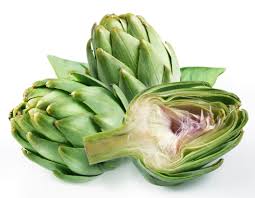
There are many ways to reap the amazing health benefits of artichokes. Unfortunately for me, it is the leaves that contain many of the artichoke's powerful health benefits. There are ways to cook an artichoke, such as steaming or braising, so that the entire bulb, stem and all, can be consumed. However, even eating just the heart of the artichoke will provide benefits.
Ingredients in artichokes have been shown to reduce cholesterol by inhibiting HMG-CoA reductase (enzyme). They raise good cholesterol (HDL) and lower bad cholesterol (LDL). One large artichoke contains a quarter of the recommended daily intake of fibre. To give you an idea a medium artichoke has more fibre than a cup of prunes.
A study done by the USDA found that artichokes have more antioxidants than any other vegetable and they ranked seventh in a study of the antioxidant levels of 1,000 different foods. Some of the powerful antioxidants in artichokes are quercertin, rutin, anthocyanins, cynarin, luteolin, and silymarin. The pulp of artichoke leaves contains a polyphenol antioxidant called cynarin which increases bile flow.
They are good for the liver thanks to the cynarin and another antioxidant, silymarin. Studies have found they may even regenerate liver tissue. Artichokes have long been used in folk and alternative medicine as a treatment for liver ailments and the scientific studies are now proving them to be correct. So really they share many health properties with extra virgin olive oil and should become a staple vegetable in our diet.
Additionally, artichokes help the digestive system. They are a natural diuretic and they aid digestion, improve gallbladder function. Thanks to their positive effects on the liver, many people swear by artichokes as a hangover treatment! So I am going to show you a fantastic hangover recipe!
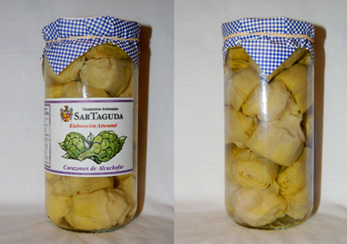 The dish I am going to share with you is fairly simple but can be a bit tedious if you don’t like peeling fresh artichokes, especially removing the hearts, which are what we want. However if you find this a pain and too time-consuming you can buy artichoke hearts already peeled in jars in most supermarkets across Spain, but as they have been preserved in liquid they do maintain a slight aftertaste. So if you want the authentic experience get fresh artichokes from the market. When buying artichokes there are a few things to take into consideration. If the artichokes are fresh they will be completely closed and the leaves will be packed tight and the artichoke will be firm and feel heavier than its size would lead to believe. The tips of the leaves should also be comfortable to touch if they are spikey and piercing the artichoke is no longer fresh. So take this into consideration when purchasing, the fresher they are the more flavour they have, simple. Today’s recipe is a Spanish classic and is often on menus around the country as a starter or a garnish for main dishes. I on many occasions just enjoy this as a main meal with a glass of wine and some bread; flavoursome, light and extremely healthy.
The dish I am going to share with you is fairly simple but can be a bit tedious if you don’t like peeling fresh artichokes, especially removing the hearts, which are what we want. However if you find this a pain and too time-consuming you can buy artichoke hearts already peeled in jars in most supermarkets across Spain, but as they have been preserved in liquid they do maintain a slight aftertaste. So if you want the authentic experience get fresh artichokes from the market. When buying artichokes there are a few things to take into consideration. If the artichokes are fresh they will be completely closed and the leaves will be packed tight and the artichoke will be firm and feel heavier than its size would lead to believe. The tips of the leaves should also be comfortable to touch if they are spikey and piercing the artichoke is no longer fresh. So take this into consideration when purchasing, the fresher they are the more flavour they have, simple. Today’s recipe is a Spanish classic and is often on menus around the country as a starter or a garnish for main dishes. I on many occasions just enjoy this as a main meal with a glass of wine and some bread; flavoursome, light and extremely healthy.
The ingredients we will need for 4 servings are the following:
12 medium artichokes
300g mushrooms with the stems removed.
150 - 200 gr of Iberian ham thickly cut (Serrano will work too but it is a bit saltier)
2 lemons
2 eggs
3 cloves of garlic
1 small dried chilli
2 tbsp. of freshly chopped parsley
2 whole stems of parsley
Salt and pepper
1 large freezer bag
Extra Virgin Olive Oil, of course!
The first step is to remove the hearts from the artichokes and this can be a bit fiddly if you haven’t done it before and very lengthy to explain so I found a video which demonstrates two techniques extremely well, it is in Spanish but just from watching it you will clearly get the idea of what you have to do.
Artichokes discolour very quickly, within a minute they are turning brown so to avoid this we need a bowl of water with lemon juice, to place the hearts in while we are still preparing the rest of the ingredients. The lemons in the ingredients list are only for this purpose. It is also a good idea to wipe your cutting knife with a lemon to avoid further discolouring.
Once the hearts are ready we need to cook the hearts in boiling water with a large pinch of salt for approximately 20-25minutes until they are tender. Place a few stems of parsley with their leaves in the water to avoid further discolouring. Once they are ready drain the artichoke hearts in a sieve and let them cool down, drying them with kitchen towel to remove any excess water.
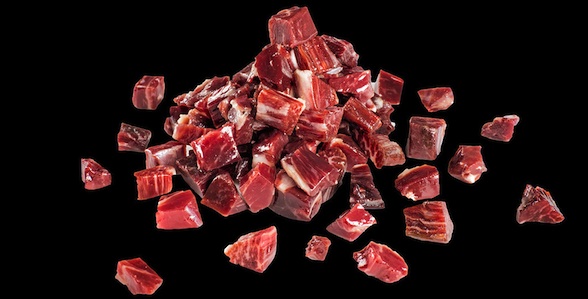 While they are cooling down we need to remove the fat from the Iberian ham and then chop up the ham into small chunks. It is best that the slices of ham are thickly cut this way the ham will not overcook when we fry it. This is especially the case if you use Serrano ham, as the thinner it is the saltier it will get when you cook it in the pan and we don’t want it too salty. This is partly why I prefer to use Iberian ham as it is firstly, better for you and also it is not a salty ham. However, both will taste great! Slice up the garlic cloves, do not chop them, they need to be in slices or they will dominate the dish.
While they are cooling down we need to remove the fat from the Iberian ham and then chop up the ham into small chunks. It is best that the slices of ham are thickly cut this way the ham will not overcook when we fry it. This is especially the case if you use Serrano ham, as the thinner it is the saltier it will get when you cook it in the pan and we don’t want it too salty. This is partly why I prefer to use Iberian ham as it is firstly, better for you and also it is not a salty ham. However, both will taste great! Slice up the garlic cloves, do not chop them, they need to be in slices or they will dominate the dish.
Beat the two eggs on a plate, as if it were for an omelette. The next step is to grab the large transparent freezer bag, pour inside enough flour to comfortably coat the artichoke hearts, 4 tbsp. should be enough. Place the artichokes inside the bag and seal of the top leaving air inside so the artichokes can freely move. Shake the bag so the artichokes are well covered and empty out the artichokes onto a plate. Start heating up the frying pan, and cover the pan evenly with extra virgin olive oil so we can shallow fry them. Make sure the oil is hot otherwise it will soak up the oil and not crisp properly. (To test the heat of the oil drop a small piece of bread in, if it sizzles and browns straight away it is ready, the oil should not smoke) Pass the floured hearts through the egg and place them in the oil until they are golden and crisp, turning them frequently. Then place them on a plate with a kitchen towel to soak up any extra oil. This is olive oil so don’t be scared of the fat, it is good for you!
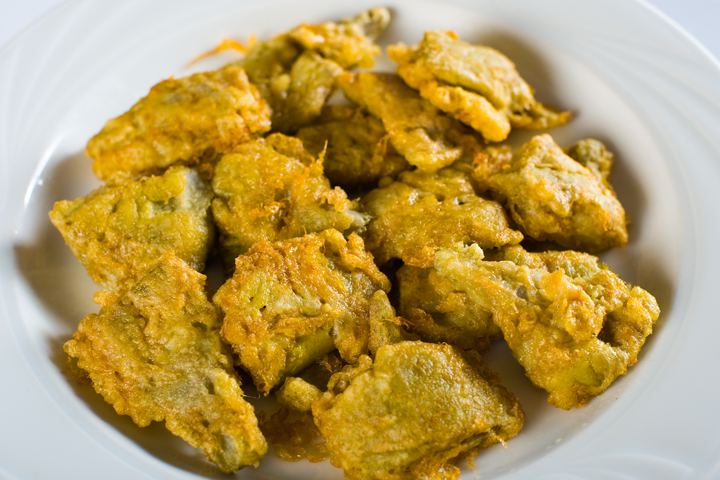

If you would rather not batter them you can jump this stage and move directly to the final stir-fry adding the artichokes as they are after boiling.**Remove the excess oil from the pan, leaving just a little for the mushrooms, ham and garlic. Heat the pan and add the garlic and the chilli, make sure it is not too hot or you will burn the garlic, on medium to low heat is best. Add the fat that you previously cut off the ham into the oil and simmer for a minute or so and then remove it along with the chilli. Next add the small cured ham chunks, fry for a couple of minutes and add the mushrooms, making sure the garlic doesn’t burn. The mushrooms you can put in whole or cut in half, but we want them in large pieces, not chopped. Add salt and pepper to taste and once the mushrooms are cooked, which shouldn’t take more than 5 minutes, add the battered artichokes and the freshly chopped parsley, stir-fry it all together for a few minutes, serve immediately and prepare yourself for an amazingly tasty meal
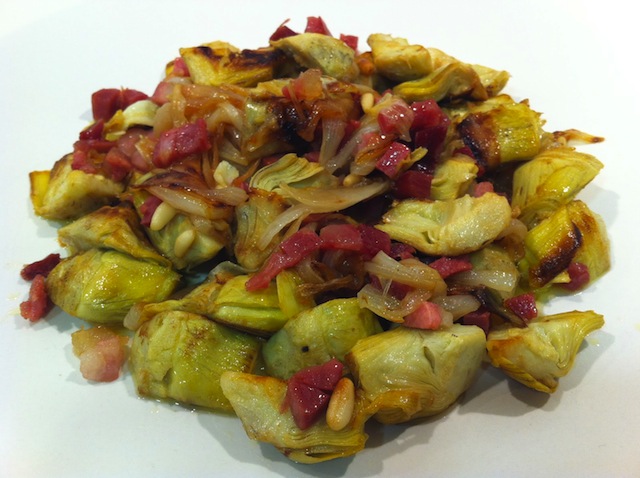
ENJOY!